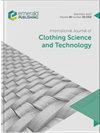日本人和中国人对织物手的感知差异
IF 1
4区 工程技术
Q3 MATERIALS SCIENCE, TEXTILES
International Journal of Clothing Science and Technology
Pub Date : 2023-03-20
DOI:10.1108/ijcst-04-2022-0050
引用次数: 0
摘要
目的本研究旨在阐明日本和中国参与者对织物手感的差异,并实施在线购物策略,使消费者能够轻松识别织物质地。设计/方法/方法招募了40名(20名日本人和20名中国人)熟悉服装和面料的参与者。参与者通过视觉和触觉对织物进行评估。刺激材料包括39个织物样品,代表了广泛的织物属性(7种纤维、5种编织/针织技术和3种纱线厚度和密度)。进行了Mann-Whitney U检验和因子分析,以确定不同织物变量的响应差异。结果两组织物手知觉因素相似。日本参与者更喜欢感觉潮湿的面料。日本参与者的织物手知觉具有3因素结构,而中国参与者具有2因素结构。中国参与者认为“脆”在感知和语言上等同于“有弹性”。独创性/价值研究结果表明,中国人对织物的偏好比日本人更强。日本人对织物手感的评价比中国人更细致,包括辨别不同的织物属性,例如纤维和纱线的厚度和密度。因此,国籍对织物手感的影响可能比织物知识更大。具体来说,在评估“清晰度”时,结果需要进一步分析,因为国籍的差异可能影响了对感知和语言视角的评估。研究结果为实施适合每个参与者群体的在线购物策略提供了设计指南。本文章由计算机程序翻译,如有差异,请以英文原文为准。
Differences in fabric hand perceptions among Japanese and Chinese individuals
PurposeThe study aimed to clarify differences in fabric hand perceptions among Japanese and Chinese participants and implement online shopping strategies that enable consumers to easily recognize fabric texture.Design/methodology/approachForty (20 Japanese and 20 Chinese) participants knowledgeable about clothing and fabric were recruited. Participants evaluated fabric by sight and touch in a visuotactile experiment (VTE). The stimulus material comprised 39 fabric samples representing a broad range of fabric attributes (7 fibers, 5 weaving/knitting techniques and 3 yarn thicknesses and density). A Mann–Whitney U test and a factor analysis were conducted to determine differences in responses for the different fabric variables.FindingsThe fabric hand perceptions factors were similar between both groups. Japanese participants showed a stronger preference for fabrics that felt wet. Japanese participants’ fabric hand perceptions had a 3-factor structure, while Chinese participants had a 2-factor structure. Chinese participants regarded “crisp” as perceptually and linguistically equivalent to “stretchy.”Originality/valueThe study’s findings suggest that Chinese people have stronger preferences in fabrics than Japanese people do. Japanese people evaluate fabric hand in a more nuanced manner than Chinese individuals, including discerning different fabric attributes, such as fiber and yarn thickness and density. Thus, nationality may influence fabric hand perceptions more than fabric knowledge does. Specifically, in evaluating “crispness,” the results required further analysis because differences in nationality may have affected evaluations regarding perception and linguistic perspectives. The findings provide design guidelines for implementing online shopping strategies adapted to each participant group.
求助全文
通过发布文献求助,成功后即可免费获取论文全文。
去求助
来源期刊
CiteScore
2.40
自引率
8.30%
发文量
51
审稿时长
10 months
期刊介绍:
Addresses all aspects of the science and technology of clothing-objective measurement techniques, control of fibre and fabric, CAD systems, product testing, sewing, weaving and knitting, inspection systems, drape and finishing, etc. Academic and industrial research findings are published after a stringent review has taken place.

 求助内容:
求助内容: 应助结果提醒方式:
应助结果提醒方式:


